
The Priory by 1907
Quick links on this page
Friary established 1265
Black Death 1349
Friary privately owned 1541
Henry Ashley re-builds 1722
Lark canal extended 1890
Becomes Priory Hotel 1975
|
History of
The Babwell Friary and The Priory
From Religious House to Accomodation and Leisure
|
1225
|
The Bury Chronicle notes that the Order of the Friars minor (Franciscans) and the Order of the Preaching Friars (Dominicans) established themselves for the first time in England. These orders would come to be a challenge to the established monastic orders in future years, both in their spiritual authority and in their claims to the moral leadership of the people.
Nine Franciscans, led by Agnellus of Pisa, had first landed at Dover on 10th September, 1224.
|
|
1226
|
By 1226 Franciscan Houses had been set up in Cambridge and Norwich.
|
|
1233
|
By 1230 the Franciscans had also established houses in Lynn and Great Yarmouth. Francis Young, in quoting the Annals of Dunstable Priory, wrote that they also wished to establish themselves in Reading and at Bury St Edmunds.
The Bury monks were sufficiently alarmed by these rumours that they obtained a Papal Bull from Pope Gregory IX confirming that no other centre of worship could be set up within one mile of St Edmund's altar. This Bull is dated December 21st, 1233, and a transcription and translation appears in Young, SRS Volume XXII of 2023.
|
|
1236
|
Discouraged at Bury, the Franciscans had set up a house in Ipswich by 1236.
|
|
1238
|
In 1238 the Franciscans and the Dominicans both appealed to the Papal Legate for the right to settle in Bury St Edmunds.
In 1238, Hawisia, Countess of Oxford, granted the Franciscan Friars a site in the town of Bury St Edmunds. Hawisia was the wife of Hugh de Vere, the 4th Earl of Oxford. We do not know where this site was located, but Friars Lane seems to be a possibility. However, the Manor of Maidwater around today's Maynewater Lane area was part of the Honour of Clare and the House of Clare was also a supporter of the Franciscans. Friar's Lane may, or may not, have been located within the manor of Maidwater, but the Franciscans seemed to have set up an unofficial base there. The Abbot challenged this, saying that St Edmund's had a spiritual monopoly within the banleuca.
Otto, the cardinal deacon of Caecere Tulliano, had been made Papal Legate in 1237, and came to England. After the Council of Oxford, he came to Bury, where the Chronicle records that the Preaching Friars appealed to him for somewhere to live within St Edmund's Liberty. After inspecting the boundaries, the
Papal Legate agreed that neither the Friars Minor (the Franciscans) nor the Preaching Friars (the Dominicans) were entitled to settle in Bury St Edmunds. The Dominicans agreed to leave, setting up in Sudbury instead, but the Franciscans would not give up so easily.
These events are rather confused in the Chronicle. We are not clear whether there was a dispute about whether the Manor of Maidwater was inside or outside the banleuca, or within the Liberty, or whether it was about the right of the abbey to a spiritual monopoly. Probably, like any legal case, several arguments were advanced at once.
|
|
1257
|
Abbey power was again challenged when the Franciscan Friars gained permission from the new Pope, Alexander IV, to settle within the Liberty of St Edmund. He granted this as an exception , knowing that this had been forbidden by a previous Pope.
They set themselves up under the abbey's nose in a farm within Northgate. The abbey expelled them despite the Pope's blessing and the Pope had to call in the Bishop of Lincoln to try to enforce his wishes. He would not call on the Bishop of Norwich for help as he was sympathetic to the Abbot's cause.
The Bury Chronicle recorded that on 22nd June the Friars Minor entered the town of St Edmund's by stealth. The Franciscans celebrated mass in an audible voice in the presence of all comers, but unknown to the convent. The local Franciscan Friars Minor were saying mass in the home of a local supporter, Sir Roger de Harbridge just by the east side of the Northgate. Meanwhile, when Sir Roger and the Friars sat down to dinner, the Abbey's supporters were demolishing the Friars' Oratory and buildings in an attempt to drive them out.
The friars had considerable support. King Henry III, Gilbert de Clare and many burgesses wanted to help them break the monopoly of the abbey within the banleuca. Despite this, not only were the Friars thrown out of town, but so was the delegation of the Bishop of Lincoln.
During July there was heavy rains and extensive areas were flooded. Much of the corn harvest was destroyed or badly damaged.
|
|
1258
|
This was a year of shortages as there had been extensive floods in July of 1257, and the price of corn had now rocketed out of reach of the poor. The Bury Chronicle said that many died of hunger.
On 25th April, the Chronicle recorded a forced entry into the town by the Friars Minor, with royal authority and armed force, led by Gilbert de Preston, the justice of the King's bench. The Chronicle said, indignantly, "This was a violation of the rights and privileges of the Liberty of St Edmund."
Sir Gilbert had a letter from the king authorising him to help the Franciscans to take over the farm of Lewis de Gerrard, located at today's Friars Lane.
|
|
1259
|
The king sent two writs to the Alderman of Bury, (Geoffrey Spot), and burgesses, over the head of the abbot, asking them to help the Franciscans. The first was in February and called on him to protect and cherish them. The second, in July, ordered him to allow the friars to build a chapel and worship there, despite the opposition of the Sacrist of the Abbey.
The Abbot still tried to make life as difficult as possible for the Franciscans.
|
|
1260
|
At about this time, Papal Commissioners were sent to Bury to try to sort out the Abbey's dispute with the Friars, but the Abbot refused to see them. The King intervened and the Friars were put up by St Peter's Hospital while their future was pondered.
|
|
1262
|
Pope Alexander died in 1261, and his successor Urban, was apparently even less sympathetic to the Franciscans. After he received a delegation from the Bury Benedictines, the Franciscan Friars were ordered to pull down their buildings in Bury and leave town.
|
|
1263
|
According to the Bury Chronicle, the Friars Minor voluntarily gave up their place in the town, despite the king's order. They had lived there for 5 years, 6 months and 24 days. A papal letter had been received ordering them to leave the said place.
King Henry III was on the side of the Franciscan Friars, particularly because his wife, Eleanor, was a supporter of the whole mendicant movement. The friars wanted to stay in West Suffolk, and with the King's support they were able to do this.
By 1265 the Abbey finally gave the Franciscans land for a permanent home at Babwell just outside the Banleuca where today's Priory Hotel stands.
|
|
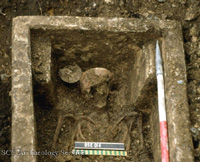
Stone coffin from Babwell Friary
|
|
1265
|
In 1265 the Abbey finally gave the Franciscans a permanent home at Babwell just outside the Banleuca where today's Priory Hotel stands. With 43 acres of land given reluctantly by the Abbey Cellarar at Bury, and financial help from the Earl of Gloucester, Gilbert de Clare, the Franciscan Friars finally founded their Friary at Babwell.
The name Babwell no longer survives, but the Priory Hotel stands within the walls of the old Friary precincts at the junction of Tollgate Lane and the Mildenhall Road. Only remnants of the walls remain visible today.
The illustration is of a stone coffin and male burial recorded during excavations at the Babwell Friary, just north of Bury St Edmunds. Beside the head are a pewter communion chalice covered with a paten (plate). This was one of the community of friars; stone coffins were uncommon and suggest that the man was of some importance.
There have also been remains of a mill found behind the Tollgate Inn, possibly associated with the Friary.
However, the Grey Friars still could not enter town without the abbot's permission, and thus were excluded from an easy involvement in civic life. It is not surprising that they tended to side with the townspeople in their disputes with the abbey. In turn they won many friends in town.
They were not the only religious dissidents against the abbey. The rectors with livings in the town, and the so-called secular priests, were treated as second class churchmen by the monks and in turn they also sided with town against abbey. This religious backing was to become important to the burgesses in their growing struggles with the great abbey.
|
|
1289
|
The king's chief justice, Thomas Wayland was indicted for harbouring some of his own men who had killed another man. He feared the King and so fled to Bury to take sanctuary with the Friars Minor, the Franciscans at Babwell. On the king's orders he was besieged by men of the neighborhood for several days. He even became a monk, or "assumed the habit", but this just caused the king to send further reinforcements to his blockade. After two months Wayland admitted defeat and gave himself up, and was taken to the Tower of London.
|
|
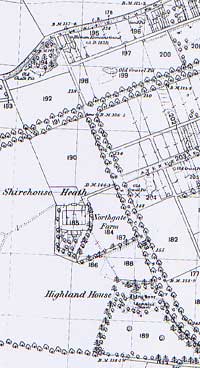
Shirehouse Heath
|
|
1301
|
Until 1301, the Royal Assizes were held at Catteshall, a location in the Great Barton area. The Abbot, with his overriding authority within the town, had always ensured that the King's Courts for the Shire, the Assizes and Quarter Sessions were held outside the banleuca. By 1301 these courts were being held at Thingoe Hill, or Henhowe Heath, as it was called then. This was not far from the church of the Friars at Babwell, and when the weather was bad at the new courts, large crowds had sought refuge in the church. The Friars petitioned the king not to let the Hall of Pleas become a permanent fixture at Henhowe Heath. This does not seem to have worked, as the area became called Shirehouse Heath, indicating that it did, indeed, become the home of the Shire House or Hall of Pleas, for the duration of the monastic period. This was made permanent by the King in Parliament in 1305. The name Shirehouse Heath survived on Ordnance Survey maps up to the 1886 edition. After the Dissolution the Shire House moved into town.
|
|
1305
|
On June 19th of the 33rd year of the reign of Edward I, membrane 20 of the patent rolls record that the following declaration was made at Parliament held at Finden:-
"Grant, after inquisition ad quod damnum made by the sheriff of Suffolk
and in consideration of a fine made in the Chancery by the abbot, to the
abbot and convent of St. Edmunds that pleas within the eight hundreds
and a half which are within the liberty of the abbot shall henceforth be held
in a place called 'Henhowe' near the town of St. Edmunds for the
convenience and use of the justices and other the king's ministers and the
people gathering there, as they used to be held in the place 'Catteshill'."
|
|
1327
|
In January the country was in turmoil, with chaos and disorder over the possible deposition or abdication of Edward II. One particular uprising took place in Abingdon, another monastic town, and news of this soon reached Bury.
On 14th January
some Londoners met local people in Bury to talk politics. Inevitably all the old grievances of the town against the abbey were aired. Thetford, Cambridge and Ipswich had held royal charters for over a hundred years, and were being governed by their own corporations. In Bury they could not even appoint Gate keepers or their own alderman without the say-so of the Abbot. The town paid tolls and fees to the abbey, and the fruits of their labour were being lost to the town.
Next day, the 15th January, about 3,000 people stormed the Abbey gates, attacked the inhabitants and ransacked the legal archives. The Vestry and Treasury were raided and robbed. They blocked all roads to London and threw about 21 monks into jail. Amazingly it is reported that 32 out of the establishment of 80 monks were in the country at the time, on holiday.
On May 19th, a new force entered the arena in Bury. The Franciscan Friars from Babwell and the secular priests turned on the abbey. The front doors of the parish churches of St James and St Mary, inlaid and jewelled, were ripped off and carried away. The priests took the jewels as they said, unlike the monks of the abbey, they got no generous stipends or income to live on. Everyone had ganged up on the abbey, and de Burton even asked the friars to take over the shrine of St Edmund. When in May the monks and their servants tried to attack some of the mob, the abbey church was burned in retaliation.
The town had set up a commune which had lasted for six months before it was now suppressed.
|
|
1328
|
John de Berton and Gilbert Barbour, the ringleaders of the 1327 revolt in Bury, escaped from gaol, and took refuge in a house of the Babwell Franciscan Friars. They stayed there from Winter to Summer. Following their enormous fine of £14,000 in 1327 some of the burgesses still refused to knuckle under.
In August the notorious outlaw gang of Thomas Thornham came to Bury to a hero's welcome by townsfolk against the protests of the Abbot, who, naturally, feared the worst. Thornham took over Moyse's Hall, and fought off the abbot's attempts to arrest him. The Abbot retreated to his Manor at Chevington Hall, a moated favourite place of Abbots from Bury. De Berton and Barbour came out of hiding and joined Thornham's band along with another burgess, one Richard Friosel. A
group of them marched on Chevington where they managed to kidnap Abbot Richard de Draughton from his moated country retreat.
|
|
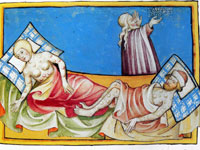
Black Death
|
|
1349
|
The years 1348 and 1349 would fundamentally re-align the development of people's lives in Medieval Suffolk, in a way that the First world War would do so centuries later. The structure of society, the relationships between the classes, and the country's economy, were all turned upside down. and It is believed that between one-third and one half of the country's population were killed by the Black Death. Many monastic houses were virtually wiped out. It was exceptionally severe in St Edmundsbury.
In January 1349 the Black Death arrived in Suffolk, perhaps first appearing at the inland port of Lakenheath, which suffered 20 deaths by February. The disease took four weeks to incubate, and death followed rapidly. Outbreaks now occurred up the Stour valley along the routes out of London. Coastal ports also introduced it into the Waveney valley.
In March the disease reached Bury St Edmunds. People started dying here in April.
By summer 1349 the Black Death was at its height in St Edmund's town. By September 1349, the Black Death had passed but the country was desolated. About 60% of all priests were dead, as were 45 to 50% of tenant farmers. Farms and stock were left to ruin as there was no skilled labour left to manage them. There was little or no normal production as employers were dead and established markets for produce were decimated. Those able to work were, for a time, able to pick and choose employers.
|
|
1381
|
St Edmunds only had 47 monks following years of plague, compared to 80 monks and 21 chaplains in 1260. It looks as if up to half the monks had died from the disease.
The Bury burgesses were in uproar about the size of their punishments over the election for abbot in 1379, which had resulted in a lengthy court case only a few months settled.
Not only that, but the new poll tax was hurting everybody. Resistance to payment led in March 1381 to new laws to enforce payment.
All over the country there was discontent, so that the poll tax became just the last straw.
Thus did 1381 become known as the year of the Peasant's Revolt. In modern times it is acknowledged that this was not a revolt of peasants, and is more properly called the Great Rising of 1381.
St Edmund's Abbey was rich and widely resented throughout West Suffolk, which included Sudbury, and since 1332 had been weakened by hard times, plague, scandal and poor rule. On 14th June Jack Wrawe entered Bury and issued a proclamation for the inhabitants to join him or face decapitation. Many needed no such threats, although some would later claim this was their reason for joining.
|
|
1448
|
Richard Plantagenet, Duke of York, owned land in the area to the north of Bury, around Babwell. He endowed some of this land to the friars at Babwell who had their priory on the site of today's Priory Hotel.
|
|
1481
|
Jankyn Smyth died and he left several important bequests. One was to the College of Sweet Man Jesus, his chantry in College Street. Another bequest was to the Franciscan Friars at Babwell, but the bulk of his will went to 24 Guildhall Feoffees drawn from the Candlemas Guild.
|
|
1536
|
The Dissolution of the Monasteries really began when the Act of Suppression authorised the closure of monasteries with an annual income of less than 300 marks (about £200). This Act began to be enforced in 1536. It covered 300 houses but about 75 were exempted upon payment of a fine. At Bury the monks thought it expedient to grant Cromwell and his son Gregory an annuity of £10 payable from the rents at Harlow.
In Bury this order did not cover the great Benedictine Abbey, but it did cause the Babwell Friary of the Franciscan Order to be shut down.
The Court of Augmentations was set up to control and administer the former monastic lands on behalf of the Crown. It also arranged and supervised any land sales and leases necessary. This court ended up with the first great privatisation of state assets, as Henry VIII dissolved all religious houses in the years to 1540. To make a quick return the King authorised a few sales or "grants" to anyone able to pay the price. There were only a trickle of sales up to 1540.
|
|
1538
|
In September, 1538, John Hilsey, a former Dominican friar, but now Bishop of Rochester, was acting as Cromwell's agent for lesser religious houses. He came to interview the Babwell warden over a report of treasonable utterances, but got the warden to agree to surrender the friary if the king or Cromwell required it. Hilsey reported this to Cromwell in a letter dated 27th September, 1538.
|
|
1539
|
The final surrender of the Babwell Friary was made in December, 1539. It was taken by Richard Ingworth, the suffragen Bishop of Dover. Ingworth was another former Dominican Friar, appoited by Cromwell to be his special negotiator with Friars.
|
|
1540
|
Apparently the property of the Babwell Friary was granted to Lady Margaret Douglas.
|
|
1541
|
The House of the Grey Friars at Babwell, with its associated property was granted in May, 1541, to Anthony Harveye, a gentleman. He rented these lands for ten shillings a year.
|
|
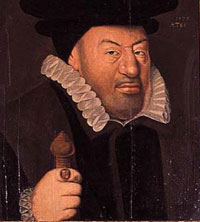
Nicholas Bacon
|
|
1544
|
Many of the former monastic lands came on the market as the King continued to cash in on his new assets. For this he relied upon the advice of the Court of Augmentations, set up under Nicholas Bacon to dispose of surplus monastic property. The King granted John Eyer, Receiver General in the County of Suffolk over 50 parcels of monastic land and property.
|
|
1546
|
Other monastic properties in and around Bury were granted to John and Andrew Manfield, and other disposals continued through to the 1570's. Eyer in particular began to sell off many of his scattered holdings and over the next 50 years there was much buying up of newly available property by adjacent owners in order to consolidate holdings and redevelop larger properties.
|
|
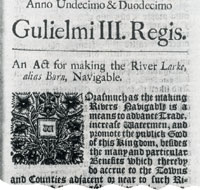
Lark Navigation Act
|
|
1699
|
In the 11th and 12th year of William III's reign was enacted "An Act for making the River Larke, alias Burn, Navigable." This Act has been dated in modern times as either 1699 or 1700. The general preamble stated that "the making of rivers navigable is a means to advance trade, increase Watermen, and promote the public good of this kingdom, besides the many and particular benefits which thereby do accrue to the towns and counties adjacent or near to such rivers."
Henry Ashley, his heirs and successors, were empowered to make the River Lark navigable from Long Common, which was just below Mildenhall Mill, to Eastgate Bridge in Bury St Edmunds. At this time the river was still navigable from Kings Lynn up to Long Common in Mildenhall.
Local traders objected to these plans, despite the fact that Ashley intended private traders to be able to construct their own wharfs alongside his own. In the end he offered to withdraw from any interest in wharfage at Bury, but for some reason the plans continued to be rejected. His navigation had to be terminated outside the Borough boundary, which crossed the river at the location of Tollgate Bridge. The nearest available land was on the northern side of the Priory Estate, adjacent to today's Somerfield supermarket store.
|
|
1716
|
The Lark navigation was now open for business from Mildenhall to Bury St Edmunds under the Act of Parliament passed in 1699/1700. By 1700 the River Lark was no longer navigable any further than Mildenhall from the sea, and so Henry Ashley obtained the Act to allow navigation as far as Eastgate Street. The Corporation of Bury were apparently afraid of him setting up a wharfage monopoly, and opposed the plan. All Ashley could do was build his canal as far as Fornham, outside the Borough boundary.
The canal seems to have been profitable immediately, largely for bringing in coal to Bury St Edmunds. Between 1716 and 1855 the River Lark would be a busy waterway linking Bury St Edmunds with Ely, Cambridge and Kings Lynn.
|
|

The Priory by 1907
|
|
1722
|
Some local interests continued to plague Ashley. In 1722 there was a dispute with Mr Ralph at Mildenhall Mill. He seems to have had a string of grievances, but he was now threatening to pull up the Mildenhall Lower Staunch. He felt that he was not getting enough water to drive his mill. Ashley had avoided such disputes at Icklingham by buying the mill himself.
Ashley had now apparently accepted that he had to make his permanent terminus at Fornham, just outside the boundary of the Borough of Bury St Edmunds. He bought the Priory Estate from Bridget Short, consisting of 8 acres including Babwell Fen meadows and Bell Meadow.
This purchase included the site of the Franciscan Friary which was dissolved around 1538. Henry Ashley is thought to have built the mansion now known as the Priory, probably incorporating some features of the remaining remnants of the friary buildings.
|
|
1730
|
Henry Ashley junr was born in 1654, the son of Henry Ashley, (1630-1700), a tanner from Huntingdon who had leased the navigation of the River Great Ouse. Henry junior had taken over from his father, and made improvements to the Ouse, and in 1699 had been the promoter of the Act to provide the Lark Navigation.
In 1730 Henry Ashley died, and in his will he divided his estate between his two daughters.
Part passed to his daughter Joanna, who was married to a Joshua Palmer, and part to another daughter married to a Mr Burch. Unfortunately they could not agree who got which assets, and from 1730 until 1742 there was a protracted legal dispute over the rights to the River Lark as well as other property. Not until 1742 was judgement concluded which gave the Lark to the Palmers. The Lark navigation would continue within the Palmer family for the rest of the century.
|
|
1742
|
From Henry Ashley's death in 1730 until 1742 there was a protracted legal dispute over the inherited rights to the River Lark and his other property. Not until 1742 was judgement concluded which gave the Lark to his daughter Joanna, who was married to Joshua Palmer. The Lark navigation would continue within the Palmer family for the rest of the century.
Along with the navigation the Palmer family now took over the Priory, a mansion on the Babwell Friary site.
|
|
1757
|
The Lark navigation and its associated lands and properties was inherited by Ashley Palmer, the son of Joshua and Joanna Palmer, nee Joanna Ashley.
|
|
1775
|
Ashley Palmer, the proprietor of the Lark Navigation, married Susanna Cullum, one of the Cullums of the Hardwick and Hawstead estates, just south of Bury St Edmunds.
|
|
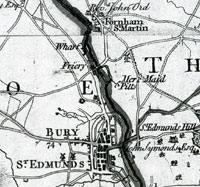
Wharf on Hodskinson's map
|
|
1792
|
Ashley Palmer had owned the Lark Navigation rights since 1757. He died in 1792, and the Lark was inherited by his widow, Susanna Palmer. She had been born Susanna Cullum, and she would manage the River Lark until she became too elderly. In 1792 she was already aged 56 years.
|
|
1807
|
Mrs Susanna Palmer, proprietor of the Lark Navigation, was 70 years old in 1806. By 1807 it seems that her nephew, Sir Thomas Gery Cullum of Hardwick House, was managing her affairs on her behalf. These included the River Lark, and part of the Great Ouse, and he was to become an enthusiastic improver of the Navigation. Provisions of the 1795 Act included several for improving the River Lark, and Cullum seems to have felt that it was now up to him to carry them out.
|
|
1829
|
Susanna Palmer, the proprietor of the River Lark Navigation, died in 1829, aged 93. The Lark navigation now passed into the hands of Sir Thomas Gery Cullum. In practice he seems to have been managing it on her behalf for some years past.
|
|
1831
|
Sir Thomas Gery Cullum the elder died in 1831, and his son, The Reverend Thomas Gery Cullum, now became the eighth, (and last) baronet of Hardwick, inheriting all his father's property and estates. It was the Reverend Sir Thomas Gery Cullum who carried out major improvements on the Hardwick House and Estate, and left his "TGC 19??" plaques on his new buildings and the improvements on the River Lark.
Also around this time the Priory was refurbished, being re-fronted and having sash windows installed. The octagonal chimney stacks may also date to this period to give the building an 'olde world' style. The house remained little changed from this time until conversion to an hotel in 1975.
|
|
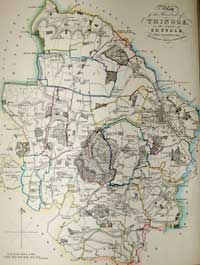
Extent of Thingoe Hundred 1838
|
|
1838
|
In 1838 John Deck of Bury published the work by John Gage entitled "History and Antiquities of Suffolk, Thingoe Hundred". This was a review of all the estates around Bury within the Hundred of Thingoe. This area contained 18 parishes and would survive as an administrative unit as Thingoe Rural District Council until 1974.
You can trace the course of part of the River Lark as far as it lay within the area of Thingoe. The Fornham Wharf is clearly marked together with Babwell Mill, Ducksluice etc..
|
|
1845
|
Records show that some 10,000 tons of goods and coals were sent from Kings Lynn to Bury St Edmunds by barge in 1845. By 1852 this trade would have dwindled to almost nothing.
|
|
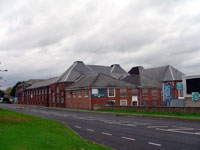
Dunnell's Maltings of 1851 |
|
1851
|
The coming of the railways had a profound effect upon the commerce of the River Lark. This navigable river extended from the Great Ouse river, through Mildenhall and upstream as far as the Fornham Wharf. This wharf was within the parish of Fornham All Saints, upon land owned at the time by Sir Thomas Gery Cullum.
Much of the land at the Fornham Wharf had been coalyards, and most of the tonnage on the river had been coal. The Ipswich to Bury railway line had been delivering coal right into Bury St Edmunds at Northgate Street since December 1846. Thomas Ridley had rented a coal warehouse from Sir Thomas at Fornham Wharf, but he no longer required its use. Sir Thomas probably did not have the money, or the inclination, to redevelop the site himself, so he let it to Robert and John Dunnell, who built a large new Malt House on the site.
|
|
1853
|
In 1853 Sir Thomas Gery Cullum mortgaged many of his assets connected with the River Lark Navigation. He mortgaged the Fornham Malting estate, raising £8,000 on it. It consisted of a malthouse, storehouse, granary, stable, yard, pumps, cisterns, kilns and furnaces. Robert and John Dunnell continued as sitting tenants of the Maltings.
Sir Thomas also raised mortgages on the nearby Friary Estate and Tollgate Estate.
|
|
1856
|
Following the death of Sir Thomas Gery Cullum in 1855, his widow, Lady Ann Cullum, was now ready and willing to sell the Lark Navigation.
|
|
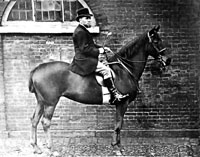
Jesse Gough c1888
|
|
1881
|
In 1870 Jesse Gough had returned from Australia and opened a large maltings at Thingoe Hill. At that time he lived at 11 Northgate Street. By 1881 he was living at the Priory, and this picture shows him mounted outside his stables at the Priory.
|
|
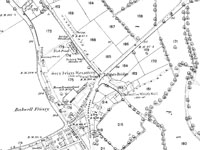
Priory area 1884 |
|
1884
|
In 1884 the Ordnance Survey published their large scale, 1:2500 maps of the area around Bury St Edmunds. As far as is known this map shows the position before the 1889/1890 river improvements when there was an attempt to extend the canal or "navigation", from Fornham All Saints into Bury St Edmunds itself, behind the St Saviours chapel ruins.
|
|
1888
|
Around this time, Jesse Gough the well known Maltster, sold the Priory to Henry Prigg, and moved to 112 Northgate Street. Henry Prigg was
Accountant at the National Provincial Bank in Bury St Edmunds, but was Hon Sec of the Suffolk Institute of Archaeology from 1865 to 1868. He also collected antiquarian material and conducted archaeological excavations, most notably at Icklingham.
|
|
1889
|
With the legislation in place which could force a reluctant canal owner to bring the navigation up to proper standards at considerable cost, the owner of the Lark Navigation was willing to dispose of his asset, which had now become a potential liability to him. In June 1889, Mr F Woodbridge sold the Lark Navigation to the Marquis of Bristol and the Mayor of Bury St Edmunds for just £26.5.0..
They were acting on behalf of the new company which was in the process of being formed, to be called "The Eastern Counties Navigation and Transport Company Limited", or the "ECN & TCL", as their new lighters would soon be blazoned.
Things moved swiftly and improvements to the river Lark at Mildenhall began straight away in August 1889, as did the construction of the new wharf at St Saviours. The dredging and canalisation of the river from Fornham Wharf to St Saviours had already begun in July 1889.
Plans were drawn up for a new bridge to carry the Fornham Road by the Tollgate Inn, and for a new lock just upstream of the bridge.
The contractor was Mr James Wilson.
|
|
1890
|
By May 1890 there were 200 navvies working on the river between the Babwell Staunch, which Howlett called the Old Clough, and the Tollgate Bridge. A new cut was made in a nearly direct line from the Fornham Maltings cut to the bridge, alongside the old course of the stream. A strip of land had been bought from Captain Ord of Fornham St Martin, to carry the cut and a towpath. Water was supplied from the old river, and also from the nearby Mermaid Pits.
During this work on the river there was some damage to the bridges at the old Friary, now known as the Priory.
Horace Barker recorded this in his book, "West Suffolk Illustrated" in 1907. He wrote,
"Near the present building is a fragment of rubble work, apparently part of a pier, and parts of the enclosure wall, and of a footbridge over the river, remain. The stream runs through an arch in the enclosure wall, and the fish ponds are left. Near them are the ruins of another ancient bridge, broken up about 1890 when the river was widened. The cement had set as hard as stone, and pick-axes were of no avail in the work of destruction."
|
|
1891
|
Despite the high hopes of 1890, for the whole of 1891 the Lark Navigation remained closed to traffic between Mildenhall and Bury St Edmunds. This put the company under extreme financial pressure as despite the immense cost of extending the navigation, there was no income from these improvements.
|
|
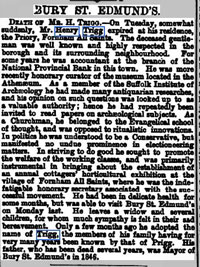
Henry Trigg dies |
|
1892
|
In September, 1892, Henry Trigg died at his home in the Priory. He was born in 1838 as Henry Prigg, but in early 1892 he changed the family name to Trigg, as related in the attached notice of his death in the East Anglian Daily Times of 7th September, 1892.
As if the Lark Navigation company did not have enough financial worries, worse was to come on Monday October 31st, 1892. Following heavy rains, the water level was high. However, the old problem of the Ickworth Park lake struck again. The water level rose so high that a deluge flowed down the river Linnet, flooded the Holywater Meadows by the Spread Eagle inn, and on into the Lark. The whole of the Tollgate inn side of the brand new Tollgate lock caved in, taking with it the gates on that side. Traffic to Bury once again had to halt until repairs costing £100 could be carried out.
|
|
1894
|
The Eastern Counties Navigation and Transport Company was in deep financial trouble. On 7th December 1894, a receiver was appointed by the Chancery Division of the High Court. He was Mr Bevan, the local banker who had issued the writ. A few days later the business was handed to a new Receiver, Charles Baker, an accountant. He was to try to run the business until it became clear that there was no hope of financial return.
|
|
1900
|
By September 1900 it was clear that the Receiver who was managing the Eastern Counties Navigation and Transport Company Limited, had decided to throw in the towel. He had been unable to raise more capital, and began to sell off the assets.
|
|
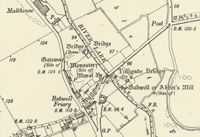
Priory area 1905 |
|
1905
|
This is the area of the Priory taken from an OS map of 1904/1905. It shows the river following the canal improvements carried out through the 1890s.
|
|
1952
|
Alderman Robert Olle carried out extensive alterations to the Priory. Sand and gravel extraction took place across the Fornham Road from the house, leaving a large excavation hole. This was known to local people as Olle's Pit.
Alderman Olle was Mayor of Bury St Edmunds in 1953/4.
|
|
1975
|
The house known as the Priory was now converted into a hotel, opening in 1976. The Priory Hotel continues to be a prestigious hotel and restaurant.
|
|
1985
|
In 1985 there was an archaeological excavation associated with an extension to the Priory Hotel. It recorded one medieval wall running E-W.
|
|
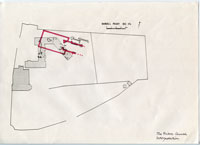
Priory excavations 1990 |
|
1990
|
Before a new extension to the hotel could take place, the Suffolk Archaeology Unit carried out an investigation of the proposed area of building. The Friary Church layout was identified, along with 23 graves with skeletal remains.
One skeleton was found in a stone coffin, with a chalice and a plate, located within the nave of the church.
It is possibly the grave of Robert of Emly, an Irish Bishop, who is known to have been buried here in 1441. The stone coffin is now located as an ornament within the flower borders of the hotel.
A gallery of pictures from this excavation can be seen by clicking here:
Babwell Gallery of Pictures
|
|
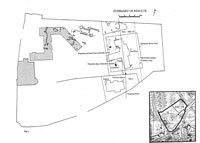
Vinery excavations 1994 |
|
1994
|
From June to August, 1994, an excavation on an area known as the Vinery was carried out in advance of the construction of two bungalows at the River Lark end of the area. There were no significant results. Much of this part of the site was probably destroyed by gravel excavation in the post-friary era.
|
|
1998
|
The Priory Hotel was now sold out of private hands to the Eagle Hotel Group.
|
|
2002
|
The hotel became the Priory Hotel Limited, a Best Western Hotel. It continues to be a Best Western in 2022, although now a part of the Cameron Ventures Hotel Group.
|
|
2018
|
The Best Western Priory Hotel embarked upon a new 100 seater restaurant, and an additional 14 bedrooms. It could now provide 54 bedrooms, each with en-suite facilities.
|
|
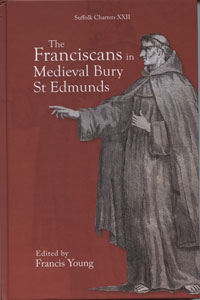
Franciscans in medieval Bury
|
|
2023
|
In 2023 the Suffolk Records Society published "The Franciscans in Medieval Bury St Edmunds", volume XXII in their Charter Series. Edited and introduced by Francis Young it brings together all of the documents and charters relating to the Franciscans in Bury St Edmunds. The conflicts with the monks at Bury has been quite well known, but their life at the Friary established in Babwell from 1265 until the Dissolution has hitherto been quite unexamined.
|
|
Quick links on this page
Top of page 1225
Babwell Friary established 1265
Black Death 1349
Friary privately owned 1541
Henry Ashley re-builds 1722
Lark Navigation extended 1890
Conversion to Priory Hotel 1975
|
Prepared for this St Edmundsbury website
by David Addy, 4th June, 2022
Books and other resources consulted:
"West Suffolk Illustrated" by H R Barker, 1907
| |


















